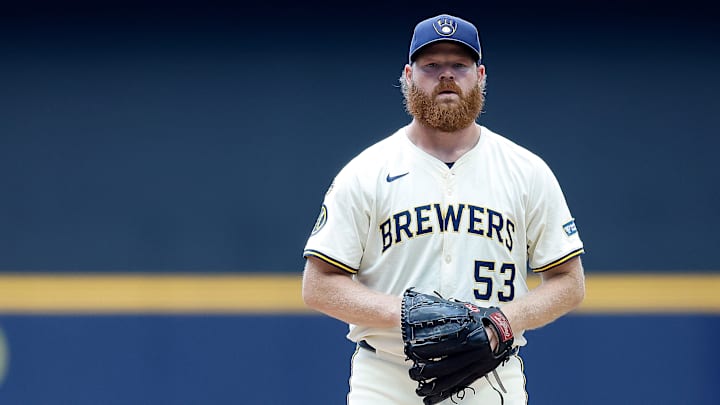When Ken Rosenthal floated the idea of the Milwaukee Brewers turning Brandon Woodruff’s qualifying-offer season into a springboard for a lower-AAV, multi-year extension, it immediately sounded like the kind of move this front office would at least kick around.
One possibility for Brewers is to sign Woodruff to a multi-year deal at a lower AAV.
— Ken Rosenthal (@Ken_Rosenthal) November 18, 2025
The Brewers have built their recent success on threading needles, buying low on risk, squeezing value out of every 40-man spot, and trusting their pitching infrastructure to turn talent into results. On paper, locking in a homegrown ace at a discount and freeing up some 2026 payroll space feels like an on-brand bit of creativity, especially for a club that can’t simply spend its way out of mistakes.
Brandon Woodruff’s extension idea tests how much risk the Brewers can stomach
However, there’s a fine line between creative and careless, and Woodruff’s case is right on that edge. With the qualifying offer ($22.025 million) already in his pocket for 2026, the Brewers have him under control for another year without adding a single ounce of extra risk. Turning that into a multi-year commitment at a reduced AAV is tempting — more flexibility now, cost certainty later, and potential cover if they decide to move Freddy Peralta.
Rosenthal’s proposal, in broad strokes, is simple enough: extend Woodruff beyond 2026 at a lower annual salary in exchange for extra years of security on his side. In the best-case scenario, the Brewers get a front-line starter under market value, and the lower AAV in the first year or two gives them more room to maneuver this winter and next. It’s the classic small-market play. Buy into some injury risk now for the chance to extract surplus value later.
There are clear theoretical benefits. Freeing up extra dollars would help address other needs on the roster, whether that’s fortifying the lineup or shoring up the bullpen. A multi-year pact would also mean Milwaukee isn’t staring at a future rotation without Woodruff anchoring it.
But every one of those pros is shadowed by the same, glaring con: Woodruff’s body hasn’t held up. Since 2023, it’s been one issue after another — right shoulder inflammation that wiped out most of that season, shoulder surgery that erased 2024 entirely, and then right ankle tendinitis followed by a right lat strain during and after his 2025 comeback. That’s not one fluke injury; that’s a pattern of upper-body and lower-body trouble that makes projecting durability over multiple seasons feel like wish-casting. If a multi-year deal goes sideways, the Brewers aren’t just out a pitcher, they’re stuck with dead money clogging a payroll that already has to be tightly managed.
Even when he’s been on the mound, there are new questions. Woodruff pitched well in 2025, but he did it with diminished fastball velocity and more finesse than brute force. That’s encouraging on one level — it shows he can adjust — but it also narrows his margin for error. The older he gets and the more mileage those injured parts absorb, the smaller the window becomes where you’re getting “ace-level Woodruff” instead of “overpaid, hurt veteran.” A multi-year deal isn’t just betting he’ll stay effective; it’s betting he’ll stay healthy enough for that effectiveness to matter.
For a big-market team, maybe that’s an acceptable roll of the dice. For the Brewers, it’s a different conversation. This is an organization that has to sweat every eight-figure commitment because one bad contract can cost them a starting-caliber position player or two quality relievers down the line. Locking themselves into multiple years of a pitcher with a reconstructed shoulder and fresh lat issues is the exact kind of high-variance gamble that can shrink a competitive window instead of extending it.
So while Rosenthal’s idea fits the creative, value-hunting image of how Milwaukee does business, the reality is harsher. The Brewers already have Woodruff for 2026 on a one-year flier. The smart play is to treat that as a prove-it season: let him show he can handle a full workload, monitor how his stuff holds up, and then reassess with more information in hand.
Turning that into an immediate multi-year extension at this point isn’t savvy; it’s simply too much risk for a team that can’t afford to whiff.
